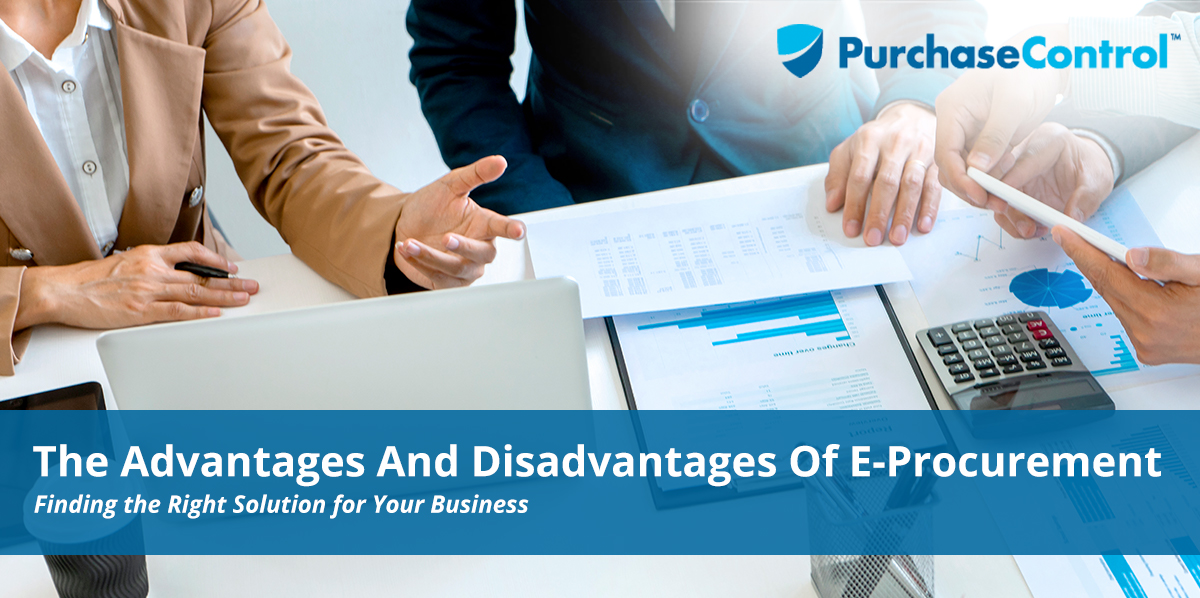Is your company ready for electronic procurement, AKA E-Procurement? As technology continues to advance, and digital transformation becomes the norm, the question will soon no longer be, “Is E-Procurement right for our organization?” but “How can we most effectively and efficiently leverage E-Procurement to support our goals for profitability, growth, and innovation?”
Like all transformative technologies, E-Procurement has its share of associated pros and cons. Building a thorough understanding of the benefits offered by E-Procurement solutions, as well as the potential disadvantages of E-Procurement improperly applied, can help you identify and implement the software tools best suited to meeting your goals for cost savings and continuous improvement in all your business processes.
E-Procurement: The Basics
Also known as e-procurement, E-Procurement software gives organizations visibility and control over all their procurement processes, ranging from the procure-to-pay (P2P) cycle to supply chain management to strategic and financial planning. Many of the most popular E-Procurement systems are what is known as Software as a Service, or SaaS, systems. They provide a centralized, cloud-based software environment that connects stakeholders, applications, and physical locations for more optimal communication, collaboration, and efficiency.
While software automation used to be somewhat exclusive to larger organizations, both small businesses and massive conglomerates use E-Procurement software today. While all businesses are unique in some way, generally speaking E-Procurement is implemented as part of a larger business process management initiative. General goals include cost savings, efficiency improvements, and greater strategic and competitive decision making, supported in part by using E-Procurement to:
- Automate and streamline business processes.
- Achieve improved transparency of, and access to, all spend data.
- Improve collaboration, analysis, and decision-making through centralized data management.
- Reduce waste, inefficiencies, maverick spend, and human error.
- Connect all applications, including existing enterprise resource planning (ERP), accounting, and customer resource management (CRM) solutions, to create a cohesive software environment driven by shared efficiency.
- Create and manage a global supply chain with optimal performance and strong vendor relationships built through strategic sourcing.
- Redefine the role of procurement as a source of value and cost savings created through actionable insights and process optimization.
Goals will vary with each organization, but in general, making the move to E-Procurement is seen as a net positive, albeit one with some challenges companies may not be prepared to tackle without proper preparation.
“While all businesses are unique in some way, generally speaking E-Procurement is implemented as part of a larger business process management initiative. General goals include cost savings, efficiency improvements, and greater strategic and competitive decision making.”
Advantages and Perceived Disadvantages of E-Procurement
With a market experts predict will grow to nearly $10 billion worldwide by 2023, cloud-based E-Procurement systems—which include dedicated purchasing systems (ePurchasing), supply chain management, and other eCommerce tools—are a force to be reckoned with by any business serious about embracing digital transformation.
Whether they’re business-to-business or consumer-facing, businesses across all sectors and industries rely on procurement to run. Making the procurement function as cost-effective and efficient as possible is a sensible goal, to be sure.
Achieving that goal is not a one-size-fits-all proposition, however. So while it’s important to acknowledge the universal benefits offered by E-Procurement, it’s also critical to understand the roadblocks and hurdles implementing such a system can present—and map out a course to avoid or overcome them.
Advantages of E-Procurement
Regardless of size, industry, or age, businesses who want to streamline and optimize their procurement function can find substantial benefits in the robust capabilities of E-Procurement software.
Through E-Procurement, companies can achieve:
- Greater Process Control and Efficiency. Artificial intelligence and machine learning are powerful tools for process automation, and you can use them to:
- Create leveled, role-appropriate access to shared data
- Build touchless processes for all your critical workflows (complete with routing contingencies for approvals)
- Build vendor catalogs connected to contract management, so every order for goods and services is made with the right vendor, at the best price, with the best possible terms and incentives—without excessive risk from maverick spend or invoice fraud.
- Connect procurement to your existing software environment for additional efficiency gains.
- Improved Communication and Organization. Centralized, cloud-based data management means everyone’s on the same page, whether they’re in the office or a thousand miles away doing business on their tablet, laptop, or smartphone.
Automation and integration remove choke points, roadblocks, and needless human error, improving overall efficiency while reducing costs and waste.
Centralized and comprehensive data storage also makes it easier to use important data analytics tools to extract actionable insights and useful forecasts built on complete, reliable information. - Substantial Cost Savings. Process optimization generates immediate and long-term savings through both initial and continuous improvements in efficiency. Your staff can stop devoting time and resources to low-value tasks, and shift their focus to high-value ones. And you can realize even more cost savings through reduced need for overhead, headcount, or investment in hardware, software, and even office supplies (automated, digital processes use far less paper and materials than traditional, manual workflows).
Fast, powerful, and with a small IT footprint, E-Procurement software doesn’t just save your company money with process improvements. You can actually build a truly cost-effective solution by investing in a bespoke, purpose-built procurement software solution.
For example, PurchaseControl specializes in procurement software solutions that include all the features your business needs, without unnecessary bloat—while still leaving room for seamless, non-disruptive scalability and expansion down the line.
Disadvantages of E-Procurement
It can be difficult to assign true “disadvantages” to E-Procurement. A better word is “challenges,” as the problems that come with implementing E-Procurement software generally fall into two categories:
- Culture Shock, i.e., difficulties related to obtaining both literal and figurative investment in digital transformation due to a lack of information, perceived limitations of the software itself, or a corporate culture reluctant to move beyond traditional models of procurement processing.
- Situation-Specific Integration Issues, usually related to a lack of planning, poor or incomplete understanding of the goals being addressed through implementation, or confusion and ignorance related to the capabilities and functionality of the chosen E-Procurement software.
Both types of challenge can be mitigated through:
- Research and planning. Needs analysis is the first step for any important update to company workflows. Researching the available features, scalability, and total cost for the solutions considered to address such needs is the second.
Research and planning are especially important in keeping costs low. It’s entirely possible your business may not need a soup-to-nuts E-Procurement solution at this time; small businesses may find a purchase order tool or ePurchasing software will adequately meet their needs now and for the foreseeable future.
Understanding your actual needs will keep you from spending too much now, while leaving room for growth down the road. Knowing what you need, and how much you’re willing and able to pay for it, will keep the cost, chaos, and crankiness to a minimum. - Education and Training. Before implementing any solution, it’s critical to get buy-in from all stakeholders, from the C-Suite down through management to office staff and vendors. Choosing a service provider like PurchaseControl, which includes in-depth education and training as part of its E-Procurement software (including training, information sessions, and refreshers before, during, and after implementation), will help you dodge common bullets such as:
- Poor performance and compliance due to user frustration.
- Supplier integration challenges (e.g., catalog integration and updates).
- Difficulties integrating direct and indirect spend into a single, cohesive system.
- Lack of strategic value due to managerial struggles in using data analytics, process optimization, and other data dashboards.
Transform Your Business for the Better with E-Procurement
The transition to E-Procurement doesn’t have to be difficult or daunting. By understanding the capabilities of E-Procurement software and opting for a purpose-built solution that handles the specific needs of your procurement function, you can reap the substantial benefits of E-Procurement while overcoming the potential difficulties. Connect with the future of procurement, and begin crafting a cost-effective future for your business built on greater efficiency, higher profits, and a stronger competitive position.
Get All the E-Procurement Features You Need, and the Support You Deserve, with PurchaseControl.
Find Out How








